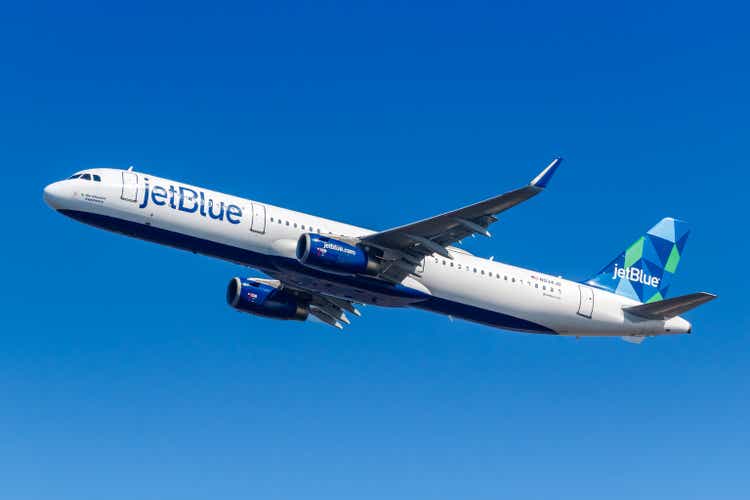Boarding1Now
Introduction
Airlines have struggled with many different market environments over the past three years. From the pandemic that ended travel to the sharp rise in jet fuel prices seen today. JetBlue (NASDAQ:JBLU) has decided to remain competitive in the industry it needs to scale, thus making a bid for Spirit Airlines (SAVE). While JetBlue has continued to post losses even after exceeding 2019 revenue and ASMs, this move may help the company deal with costs in the long run.
This Year So Far
At the midyear point of the fiscal year, JetBlue has seen total revenue growth of 87.4% compared to last year. This shows the continual rebound in demand for air travel in the United States. ASMs and RPMs also grew by 39.8% and 49.9%, respectively. So far, the load factor is solid at 78.3%.
But the operations are still struggling, nonetheless. Operating and net income is still negative at -$780 million and -$443 million. This is despite having revenue and ASMs higher than 2019’s levels. JetBlue saw PRASM and CASM for the period of $0.1228 and $0.1466 cents each, for a margin of -$0.0238. The reason for this operating deficit is the fact that aircraft fuel increased in price by 179.6%. So while air travel demand was increased, along with a 26.7% ticket price gain, the airline is not meeting the difference in costs from fuel price gains.
Overall, JetBlue is back to pre-pandemic levels of service, but the costs of doing business have increased drastically, therefore, causing losses. The issue is these jet fuel prices don’t seem to be coming down anytime soon. I would expect JetBlue to continue to post losses for the foreseeable future.
The Spirit Merger
Also announced this year was JetBlue’s takeover of Spirit Airlines, overriding the deal with Frontier. JetBlue offered to buy Spirit for $3.8 billion, paying $33.50 per share in cash. The idea of this was to be able to compete with the larger airlines. But what does a combined company look like? I will explore a rough idea of the combined financials from the last fiscal year.
Combined Operations
Putting together JetBlue and Spirit financials in 2021 show an airline with 455 total aircraft of the Airbus variety. This is an increase of 61% from what JetBlue had prior. The combined businesses would have flown a total of 100,862 million ASMs in the year and 73,276 million RPMs, making a load factor of around 73%. The total revenue of the business would be $9.268 billion, making it the sixth-largest airline in the United States. While 2021 wasn’t the greatest year for each business, the combined company would have posted an operating and net loss of $137 million and $655 million, respectively. The combined PRASM and CASM would have been $0.0919 and $0.0932, for a margin of -$0.0013. Overall, looking back at a combined company shows no real benefit to the businesses. But becoming larger does offer scale, which I think will better position the airline for cost efficiencies in the future. It will be key to watch if this does play out, though.
Balance Sheet
The merger really affects JetBlue’s balance sheet. As the business has offered $33.50 per share in cash, the debt load will increase. While the combined company still has a good current ratio of 0.82x, the debt-to-equity would increase to 3.91x. Not terrible and manageable if cost efficiencies are realized. Because I am assuming no more shares will be issued, the book value stays the same at $10.71 per share.
Valuation
This leads me to valuation, where JetBlue with Spirit added offers some interesting value. At a price per share of around $6.50, the new JetBlue-Spirit company would be priced at a P/BV of 0.61x and a P/S of 0.23x. Obviously, each business is running losses right now, but this is a bargain if you believe in the strategy JetBlue is taking.
Conclusion
Overall, I don’t think JetBlue is the best purchase in the airline segment. I have some belief that the Spirit deal could benefit the business in the long term, and the valuation is fair for the current business, but I like consistency in my airliners and low debt load. This is why I will stick with my position in Southwest (LUV) and dollar cost average of that position.


Be the first to comment